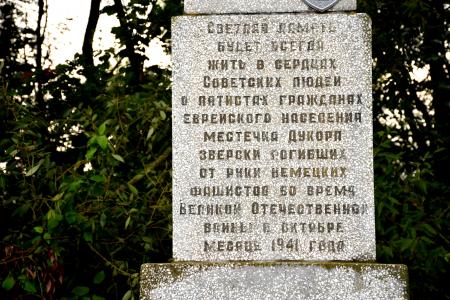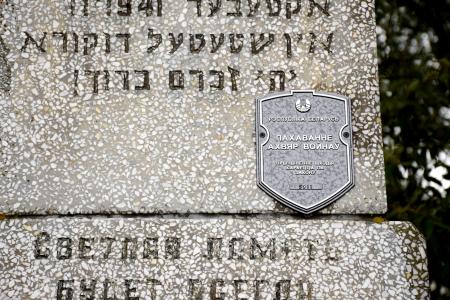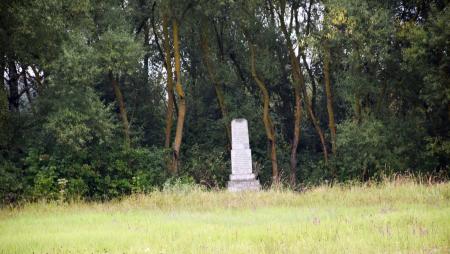Obj. ID: 34163
Jewish Funerary Art Holocaust Monument at the Killing Site in Dukora, Belarus, 1960s

Memorial name:
No official name.
Who is commemorated?
500 Jewish Holocaust victims from Dukora, shot to death by the Nazis in October 1941.
Description:
The monument is erected at the Svisloch Bridge in the Dukora killing site/mass grave. It is shaped like two tombstones standing one-on-one that, in turn, are placed on a three-step pedestal.
The monument bears two non-identical inscriptions: in Yiddish and Russian. On the upper tombstone, there is also a plaque indicating that the present monument stands at the war victims' burial site, protected by law.
The monument's territory is surrounded by a fence.
Inscriptions:
On the upper tombstone:
In Yiddish
[...]
Translation:
On the lower tombstone:
In Russian
Светлая память
будет всегда
жить в сердцах
Советских людей
о пятистах гражданах
еврейского населения
местечка Дукора
зверски погибших
от руки немецких
фашистов во время
Великой Отечественной
войны в октябре
месяце 1941 года
Translation: The bright memory / will always / live in the hearts / of the Soviet people / of the five hundred civilians / of the Jewish population / of the village of Dukora / who brutally perished / at the hands of German / fascists in October 1941 during the Great Patriotic War.
On the plaque:
In Belarusian
Рзспублiка Беларусь
Пахаванне
ахвяр войнаў
Прычыненне шкоды
караецца па
закону
5911
Translation: The Republic of Belarus / The burial site / of war victims / Infliction of harm / is punishable by law / 5911.
Commissioned by
The victims' relatives.
sub-set tree:
Dukora was occupied by the Germans at the end of June 1941. In August, a ghetto was set up there [Yad Vashem: The Untold Stories]. The execution took place on October 10, 1941, when between 394 and 500 Dukora Jews were taken to a field near Svisloch Bridge and shot to death there. The execution was conducted by a German reserve police battalion with the participation of Lithuanians and local police [The Map of Holocaust by Bullets: Yahad-In Unum].
A monument to the Jewish victims was erected at the Svisloch Bridge in the mid-1960s. The money for the monument was donated by Jews who were born in Dukora [Yad Vashem: The Untold Stories].
Today the monument is the place of the commemorating ceremonies.
"Dukora,"
Untold Stories - Murder Sites of Jews in Occupied Territories of the USSR (Yad Vashem project), https://collections.yadvashem.org/en/untold-stories/community/14622043.
"Execution of Jews in Dukora,"
The Map of Holocaust by Bullets, Yahad-In Unum, http://www.yahadinunum.orgwww.yahadmap.org/#village/dukora-dukor-minsk-belarus.1421.






